|
| |
Back to
airliners

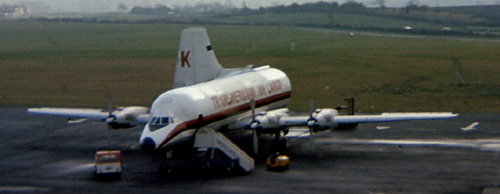 |
The Canadair CL44D-4 was a conversion of the
Bristol Britannia to take Rolls-Royce
Tyne turboprop engines in place of the original Bristol Proteus, and
incorporate a new fuselage specially optimised for freight. It first
flew in November 1960. A particular feature was that the entire tail
section can swing sideways to give an unobstructed straight line for
loading. Only 27 were built. These CL44s
were pictured at Stansted in the mid 1970s. Note the one on the
right, which has an outsize fuselage along the lines of the Guppy
and Airbus ST, but not quite as grotesque: this is the one and only
Conroy CL-44-O conversion, and I believe is the only CL44 still in
existence in 2005. The lower picture shows the CL-44-O loading at
Newcastle in February 1975. |
 |
The Canadair RJ is a 52 seat regional jet,
competing directly with the Embraer 145, derived from the Canadair
Challenger executive jet. It first flew in May 1991, since when over
1,200 have been built. Powered by two GE CF34 turbofans of 9,220lb
thrust, it cruises at 460mph for up to 2,200 miles.
Heathrow, July 2005 (with apologies for the glare through the glass
in the terminal window). |
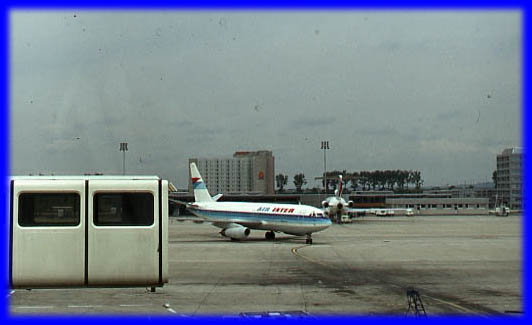 |
The Dassault Mercure was a bold venture by
French aircraft manufacturer Avions Marcel Dassault to create a
European rival to the Boeing 737. It didn't work. It first flew in
May 1971, by which time the 737 and DC9 were firmly established as
the leaders in that market, and it offered no advantages. Only ten
were built, all of which were operated by French State internal
airline Air Inter.
This is the nearest I ever got to a Mercure,
at Paris Charles de Gaulle airport in June 1983. |
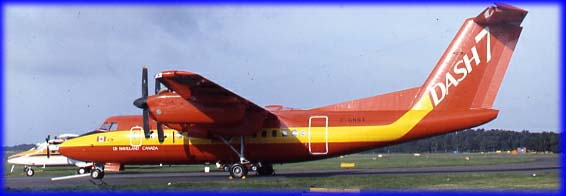 |
De Havilland Canada continued their run of
specialist short take-off & landing (STOL) aircraft with the DHC7 Dash 7.
The first one flew in March 1975, and they were quickly adopted by
airlines needing excellent short field performance. It is the only
airliner certificated to land on a 7 degree glideslope (industry
standard is 3). Seating up to 54 passengers, its four engines make
it expensive to operate, and it is quite slow for its class (230
knots). These attributes have kept volumes low, though they perform
well with niche airlines who operate to difficult and remote
airstrips. This company demonstrator (C-GNBX)
was seen at Farnborough in September 1978. |
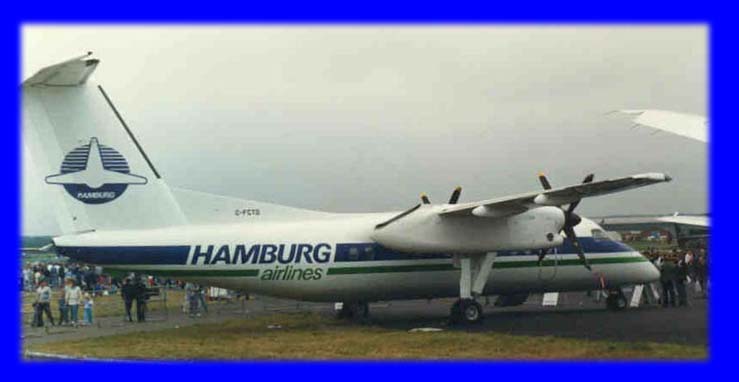 |
Built in Canada by de Havilland Canada, now a
division of Bombardier, the Dash 8 is the latest in a line of
successful aircraft produced by the Canadian company. It is a small,
short range airliner with seating for up to 40 people and a typical
range of up to 1,000 miles. It is widely used throughout the world,
mainly by small airlines on low density routes or feeding traffic
into hubs for bigger airlines. It first flew in 1983.
This example is seen at the Farnborough Air
Show in 1986, shortly before its delivery to Hamburg Airlines in
Germany. |
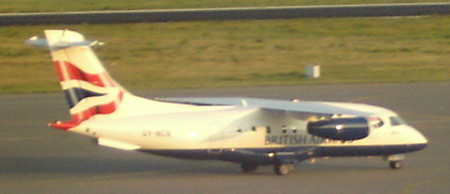 |
Dornier 328JET
Brussels, September 2007 (slightly distorted image taken through
glass) |
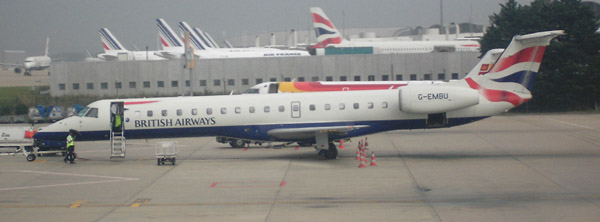 |
The Embraer EMB145 is a thin-fuselaged 50
seat regional airliner, which competes with the Canadair RJ. It
first flew in August 1995, since when over 650 have been built. Its
two Allison AE3007 of 7,040lb give it a cruising speed of 490mph and
range of 1,700 miles.
(Paris - Charles de Gaulle, July 2005) |
 |
The Dutch Fokker F27 Friendship was
ostensibly a rival to Britain's Handley Page Herald, but was much
more successful. It shared the same Rolls-Royce Dart turboprop
engines, but had a cleaner and more pleasing appearance. It first
flew in November 1955, thus establishing itself in the market
earlier than the Herald. It normally seats about 50 passengers. 787
were built, including more than 200 under license by
Fairchild-Hiller in the USA, before it was superseded by the similar
Fokker 50 in the 1990s. This F27,
operated by Air Anglia, was seen at Newcastle in May 1976. |
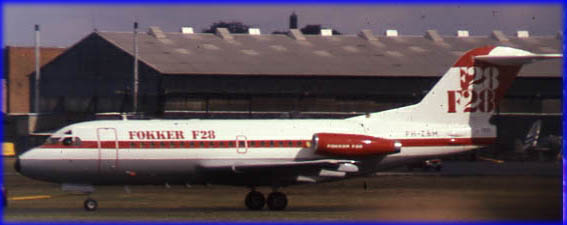 |
The Fokker F28 Fellowship was intended as a
jet successor to the F27, but ended up serving a different market
sector. It was bigger, seating 85 people, and longer range (1,200
miles versus 700). It first flew in May 1967. 240 were built before
it was superseded by the Fokker 100 in the 1990s.
This company demonstrator was seen at Farnborough
in September 1976. |
 |
The Fokker 100 is an upgraded and updated
Fokker Fellowship. It is larger (seating up to 120), and powered by
two 13,850lb Rolls-Royce Tay turbofans, it cruises at 500mph for a
range of 1,900 miles. It first flew in November 1986. 283 were built
before Fokker went bankrupt, and production perforce ceased.
This one, belonging to the Dutch airline KLM, was
landing at Cardiff in April 2006. |
 |
The NAMC (Nippon Aircraft Manufacturing
Company) YS11 is unusual in being an entirely
Japanese airliner. A contemporary of the British HS748, which it
closely resembles, the YS11 is also powered by Rolls-Royce Dart
turboprop engines. It first flew in 1962. It can take up to 60
passengers for a maximum range of 1,300 miles. 160 were built. Many
are still in service today, mainly in the Asia - Pacific region.
This one was seen at Cebu in August 2005. |
 |
The SAAB SF340 is the Swedish company's only
foray into the airliner sector (see under military fighters &
trainers for its more normal products). Originally a joint venture
with Fairchild in the USA, they pulled out to leave it a purely
Swedish venture. It first flew in January 1983. Seating 35, it is a
strong competitor in the short-haul regional airliner market.
This one was photographed at Paris - Le
Bourget in May 1983. (Note: SAAB stands for `Svenska Aeroplan AB'). |
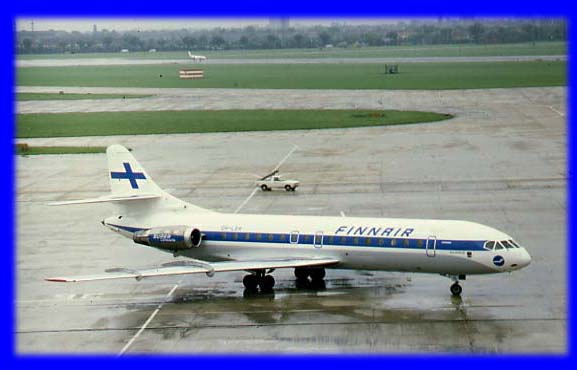 |
The Sud-Est Caravelle was a pioneering
design, being the first jet airliner to have two engines mounted at
the back: this has since become a standard design layout. Designed
by SNCASE (Societe National pour le Construction Aeronautiques du
Sud-Est), it first flew in May 1955 and was immediately successful.
Unlike many British designs, it was intended for customers rather
than having state requirements imposed on it. It carried up to 100
people, and had a range able to fly directly from Paris to France's
North African colonies. It was powered by two Rolls-Royce Avon
turbojets. 282 were built. The few remaining are now supported by
Aerospatiale, which was formed by merger of the former regional
manufacturers including Sud-Est. This one,
operated by the Finnish national airline, was seen at London
Heathrow in the mid 1970s. |
 |
The VFW-Fokker 614 was a joint venture
between VFW in Germany and Fokker in Holland. It is very unusual in
having its two jet engines mounted above the wing - a device to
shorten the length of undercarriage and reduce the risk in ingesting
debris from poorly paved surfaces, without having to pay the
structural penalty of a T-tail. Unfortunately it also reduced the
efficiency of the wing, unlike in the Antonov An72 where the forward
mounted position gives jet airflow over the wing. It was not a
success. This company demonstrator was
also seen at Farnborough in September 1976. |





|